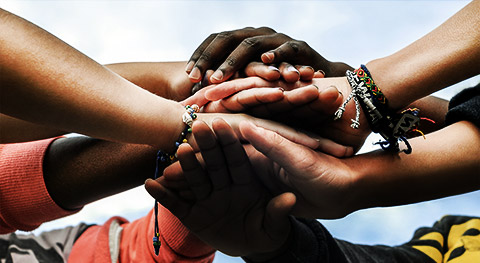Prince-Robertson, R., & McDonald, M. (2011). Working with Indigenous children, families, and communities: Lessons from practice. Melbourne, VIC: Communities and Families Clearinghouse Australia. https://aifs.gov.au/cfca/publications/working-indigenous-children-families-and-communities
Planning and delivering services to Aboriginal and Torres Strait Islander children, families, and communities can be a complex task for practitioners and policy-makers. Social problems are often deeply entrenched, and need to be approached with consideration of historical, social, community, family and individual factors. Furthermore, as Australian Indigenous cultures are not homogenous, Indigenous communities can differ considerably. Indigenous communities often have characteristics specific to geographic location, with significant variation evident across urban, rural, and remote communities (Neckowaya, Brownleea, & Castellana, n.d.).
Methods that child and family services can use to support Indigenous families and communities include:
- Working with (rather than working “on”) Indigenous communities;
- Ensuring your service is culturally competent;
- Focusing on attracting and retaining the right staff;
- Cultivating networks and relationships; and
- Adopting an action research approach.
Many Indigenous families and communities in contemporary Australia face immense challenges. Their strength and resilience is compromised by multiple complex problems, including historical and ongoing dispossession, marginalisation, and racism, as well as the legacy of past policies of forced removal and cultural assimilation (Human Rights and Equal Opportunity Commission, 1997). These issues contribute to the high levels of poverty, unemployment, violence, and substance abuse seen in many Indigenous communities. They also impact negatively on Indigenous children, who demonstrate poor health, educational, and social outcomes when compared to non-Indigenous children (Australian Institute of Health and Welfare [AIHW], 2009).
Additionally, there is a number of factors that inhibit the successful delivery of services to Indigenous families and communities. A lack of appropriate infrastructure can hinder the logistics of service delivery. Demanding workloads and low remuneration make staff burnout a common issue. Difficult social environments—with low levels of trust, participation, social control, and efficacy, and high levels of anxiety, disempowerment, disorganisation, and mobility—provide the context for much service delivery. Finally, evidence regarding effective responses to problems in Indigenous communities is limited (Scougall, 2008).
Despite the complexity of these issues, there are services that are working effectively to reduce Indigenous disadvantage in Australia (Flaxman, Muir, & Oprea, 2009; Scougall, 2008). The lessons learnt from these services about what works are critical to ensuring improved outcomes for Indigenous children, families and communities. The impetus to deliver improved outcomes for Indigenous children, families and communities is strengthened by the Council of Australian Governments’ (COAG) Indigenous reform agenda (2010), referred to as “Closing the Gap”. This reform agenda aims to “close the gap” on Indigenous disadvantage across 6 key areas— life expectency, child mortality, access to early childhood education, literacy and numeracy, education attainment, and economic partcipation (COAG, 2010).
This Practice Sheet summarises those lessons and is likely to be of most use to organisations, services, agencies and program/project managers who are planning or delivering Indigenous-specific services, or who are operating in areas where there are large numbers of Indigenous service users.
For more information about research evidence on what works to close the gap on Indigenous disadvantage, visit the Closing the Gap clearinghouse.

Practice considerations are general principles based upon lessons from research and practice designed to provide additional guidance to service providers about specific issues relating to children and families, especially as they relate to disadvantaged Australian communities. The following practice considerations are elaborated upon using case studies.
What methods can child and family services use to support Indigenous families and communities?
Work with Indigenous Communities.
I approached the Elders and involved them … And they become part of it and they’d say, “We’d like to sit on your advisory [board]”. And in the Aboriginal community, if we’re doing a good job, then everybody knows about it. (Indigenous service provider, as cited in Higgins & Butler, 2007, p. 11)
In the past, some service providers have been criticised for not involving the community in service delivery. Services for Indigenous Australians are most effective when the community is involved in both their planning and implementation stages. When Indigenous Elders, community members, and other local service providers are engaged in a consultative process, the most important needs of the community can be distinguished and the most appropriate methods of implementation can be identified.
Working with (rather than working “on”) Indigenous communities can be achieved when service providers adopt the following principles:
- Involve community members. This includes involvement in both planning and implementation of the service.
- Identify pressing needs. It is important to communicate with community members in order to identify their most pressing needs. Experience suggests that it is often best to start with small and achievable objectives, rather than trying to take on too much too early. Early successes often have a “ripple” effect, inspiring community confidence and motivating service staff.
- Utilise existing networks, services, and resources. Some Indigenous projects have very successfully “piggybacked” services on the back of existing activities, social events, and structures.
- Balance the talking with the doing. In the past, too much community consultation and a subsequent failure to follow through with action has, understandably, led to cynicism among some Indigenous communities. It is important to balance consultation with implementation. This can be effectively achieved if an action research approach is adopted (see the “Adopt an action research approach” section in this paper).
For more information on working with Indigenous communities see: Scougall (2008, pp. 66–67) and Higgins (2004).
Ensure that your service is culturally competent.
When I was 9, I was in a really bad place. Experiencing all that I had, I felt like I had lost my soul. I still remember the day I arrived at the agency, it was a lot for me ‘cause I had only had some bad experiences with white fellas before. But there was a Koorie Flag on the wall and a plaque saying your office was on Wurrundjeri land and even though I’m Yorta Yorta I thought maybe, just maybe, it would be different. (Indigenous service user, as cited in Victorian Aboriginal Child Care Agency, 2008, p. 52)
Indigenous Australians have maintained cultures that are in many ways distinct from that of mainstream, non-Indigenous Australia. This cultural difference has implications for both policy and practice. If services do not adapt to the contemporary Indigenous cultural context, they have little chance of improving outcomes in the long term. To be culturally competent, service organisations need to ensure that cultural knowledge shapes (1) the structure of the service; (2) the specific practices and strategies employed; and (3) the selection, training, and actions of individual staff members (as discussed in the section “Focus on attracting and retaining the right staff”).
The following tips on culturally competent service structure and culturally competent practices and strategies will help ensure cultural competence.
Culturally competent service structure
- Deliver services in a creative and flexible manner in response to the changing needs of the community. This includes flexibility not only in the ways that services are provided, but also where they take place.
- Involve Indigenous community members in the planning of the service structure.
- Conduct programs in informal, non-threatening settings such as in a person’s home (even if only initially).
- Ensure that costs to service users are kept to a minimum.
Culturally competent practices and strategies
- Conduct services “in language” (the first language of local people) or, failing this, have translators or people who can present information in plain, accessible English. It is also important to ensure that any metaphors or examples used take account of Indigenous world views and experiences.
- Involve cultural artefacts in services and everyday activities (e.g., traditional Indigenous tools, foods, and artwork).
- Consult and involve family, extended kin networks, and community members in service delivery.
- Invite Indigenous Elders to participate in the program delivery.
For more information on Indigenous cultural competence see Flaxman et al. (2009, pp. 23–28) and the Victorian Aboriginal Child Care Agency (2008).
Focus on attracting and retaining the right staff.
What makes it work is people. The staff have expectations of themselves and of colleagues. They’re self-managing. The quality assurance [of the program] comes from the staff. (Indigenous service provider, as cited in Higgins & Butler, 2007, p. 13)
Competent and capable staff members are key to the success of any social service delivery. This is especially true for Indigenous-specific services, where success is often largely dependent on cultural competence and the development of trusting relationships with the community. A strong team in an Indigenous-specific service will have staff who have the following characteristics:
- Strong relationships with Indigenous program participants. This will often be achieved by employing local people as part of a team, who bring with them a deep understanding of cultural issues and a respect for local protocols.
- Personal qualities necessary to work cross-culturally. The ability to carry out “cultural translation” is particularly important. It is necessary that staff members are able to communicate effectively with and between both external stakeholders and program participants.
- Demonstrated skills to do the job. Many projects require people with specific qualifications or expertise in areas such as childhood development, counselling, capacity building, and leadership development.
For more information on attracting and retaining the right staff when working with Indigenous communities, see Scougall (2008, pp. 53–55) and Flaxman et al. (2009, pp. 28–30).
Cultivate networks and relationships.

Working in partnership with a wide range of local services has been integral to the success of the Project. (Indigenous Project Progress Report, as cited in Scougall, 2008, p. 62).
Research strongly suggests that services working in isolation often struggle to meet the complex needs of vulnerable and at-risk families (e.g., Indigenous families). Services that form partnerships and collaborations with other local community and government organisations are better able to ensure that those in need receive the right assistance. Some examples of organisations with which Indigenous-specific services have collaborated are:
- Government departments and organisations (e.g., housing services, family services, Centrelink);
- Other local service providers, both mainstream and Indigenous-specific (e.g., drug and alcohol services, community counselling services);
- Health care providers (e.g., health care and sexual health clinics, mental health services);
- Indigenous cultural centres and organisations;
- Schools, TAFE institutions, and universities;
- Child care centres, parenting education providers, and toy libraries; and
- Local businesses and shops.
For more information on collaboration with Indigenous-specific services, see Scougall (2008, pp. 60–62) and Soriano, Clark, and Wise (2008).
Adopt an action research approach.
Our critical community of action researchers working together, reflecting, sharing, and thinking includes the Yolngu elders, the Yolngu action group, Balanda [non-Indigenous] teachers, and a Balanda researcher to help with the process. Of course, she [the researcher] is involved too; she cares about our problems, she has a stake in finding solutions—this too is different from the traditional role of a researcher. (Mandawuy Yunupingu, then head of the Yirrkala Ganma Education Project, as cited in Denzin & Lincoln, 2005, p. 584)
Action research is a participatory group process aimed at continual evaluation and improvement of practice. It helps to tailor projects to local environments and situations. An action research approach may be useful to services during the planning phase of a program. It has been noted that there is compatibility between action research methods and traditional Indigenous cultural practices and ways of working. Action research involves a dynamic and cyclical process of planning, acting, observing, and reflecting:
- Planning: team members and interested parties come together to define the problems they are facing and to identify the most appropriate ways to tackle these problems;
- Acting: the team proceeds with their planned activity or program of activities;
- Observing: the team observes the operation of the program, gathering information and seeking feedback from all involved;
- Reflection: team members reflect on their observations, and identify areas where there is room for improvement; and
- Planning: the cycle begins again, taking account of what has already been learned.
For more information on the action research approach, see Scougall (2008, pp. 62–65) and Lienert (2002a, 2002b).
Working with Indigenous families: Practice examples
There are many examples within CAFCA’s Promising Practice Profile database of promising and innovative methods that have been used by services and programs to support Indigenous families and communities.
For example, one program delivers locally inclusive and culturally respectful pregnancy and parenting education for young people, especially those in rural and remote Indigenous communities. The program was developed in response to community and school-based requests. Community members are involved in each step of the planning and administration of the program. This involves:
- Extensive preliminary promotion, liaison, and networking with key community members: including Indigenous Elders and members of the community health sector, the educational sector, appropriate government departments, women’s centres, youth services, and local community stores;
- Comprehensive needs analysis: to guarantee that the program meets the unique needs of individual communities;
- Fluidity and flexibility around training approach and timing: so that activities do not conflict with local community customs (e.g., inappropriate site selection) and events (e.g., festivals, funerals); and
- Discussion, negotiation, and careful consideration of program content and manner of delivery: to ensure that activities incorporate traditional/cultural practices and address any language or literacy needs.
Another service, an early intervention program for at-risk young people between the ages of 12 and 17, consists of intensive weekend camps and follow-up support groups; 30% of their clients are Indigenous. At the camps, young people can talk through issues that are affecting their lives and learn how to more effectively handle them. The Program’s innovative staff structure includes three key roles:
- Youth leaders. The leaders facilitate most of the sessions. Youth leaders are people aged 12 to 17 years who have been through three or more camps themselves, who have made positive changes in their lives, and who are dedicated to living by a Youth Insearch Code of Ethics. It has been found that youth leaders are often powerful, credible role models for program participants. It can be a transformative experience for disenfranchised Indigenous youths to see their peers taking steps to improve their own lives.
- Youth liaisons. These are full-time employees with a diploma or degree in Youth Work and/or Community Services. They organise and support the youth leaders.
- Indigenous volunteers. Indigenous volunteers assist in creating a trusting environment for Indigenous youth leaders and camp participants, and help to interpret culturally sensitive issues. They are part of a wider group of volunteers who work together to support the youth leaders in conducting camps.
For a full list of Promising Practice Profiles relating to Indigenous families and communities,
See: www.aifs.gov.au/cafca/topics/targetgroup/targetgroup.html#indigenous.
